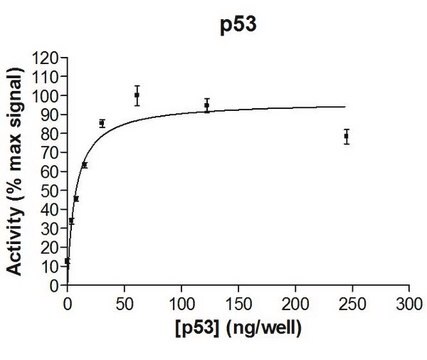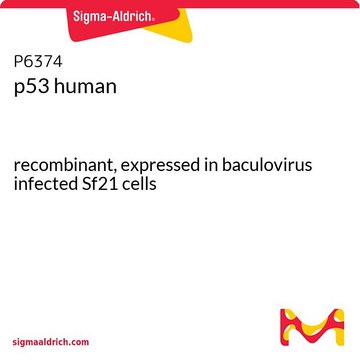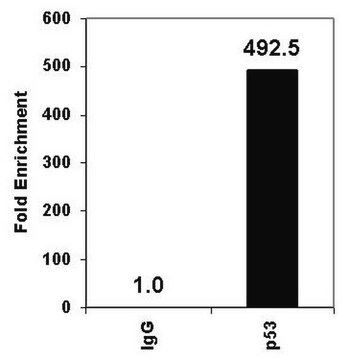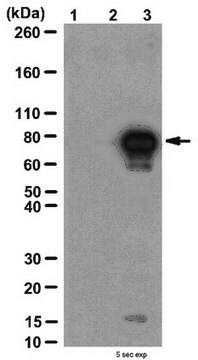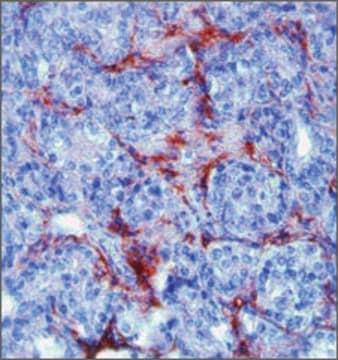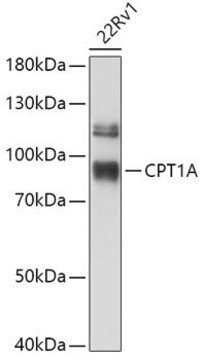ABE286
Anti-acetyl-p53 (Lys120) Antibody
from rabbit, purified by affinity chromatography
Sinonimo/i:
Cellular tumor antigen p53, Antigen NY-CO-13, Phosphoprotein p53, Tumor suppressor p53
About This Item
IP
immunoprecipitation (IP): suitable
Prodotti consigliati
Origine biologica
rabbit
Livello qualitativo
Forma dell’anticorpo
affinity isolated antibody
Tipo di anticorpo
primary antibodies
Clone
polyclonal
Purificato mediante
affinity chromatography
Reattività contro le specie
human
Reattività contro le specie (prevista in base all’omologia)
porcine (based on 100% sequence homology), canine (based on 100% sequence homology), rabbit (based on 100% sequence homology), sheep (based on 100% sequence homology)
tecniche
dot blot: suitable
immunoprecipitation (IP): suitable
N° accesso NCBI
N° accesso UniProt
Condizioni di spedizione
wet ice
modifica post-traduzionali bersaglio
acetylation (Lys120)
Informazioni sul gene
human ... TP53(7157)
Descrizione generale
Specificità
Immunogeno
Applicazioni
Immunoprecipitation Analysis: 1 µg from a representative lot immunoprecipitated acetyl-p53 in p53 transfected H1299 human lung cotransfected with or without hMOF (Prof. S. McMahon, Kimmel Cancer Center of Thomas Jefferson Medical College).
Immunoprecipitation Analysis: 1.5 µg or 4.5 µg from a representative lot immunoprecipitated endogenous acetyl-p53 in HCT116 cell lysates, which were treated with a vehicle (DMSO) or camptothecin (CPT) (Prof. S. McMahon, Kimmel Cancer Center of Thomas Jefferson Medical College).
Immunoprecipitation Analysis: 1 µg from a representative lot immunoprecipitated acetyl-p53 in H1299 cell lysates, which were transfected with either wild type p53, the 9 K/R mutant (all lysine residues except Lys120 mutated to arginine), the 10 K/R mutant (all lysine residues mutate including Lys 120), or empty vector, with or without hMOF (Prof. S. McMahon, Kimmel Cancer Center of Thomas Jefferson Medical College).
Epigenetics & Nuclear Function
Transcription Factors
Qualità
Dot Blot Analysis: 1 µg/mL of this antibody detected acetyl-p53 in acetylated p53 peptides
Descrizione del bersaglio
Stato fisico
Stoccaggio e stabilità
Risultati analitici
Non-acetylated and acetylated p53 peptides
Altre note
Esclusione di responsabilità
Non trovi il prodotto giusto?
Prova il nostro Motore di ricerca dei prodotti.
Codice della classe di stoccaggio
12 - Non Combustible Liquids
Classe di pericolosità dell'acqua (WGK)
WGK 1
Punto d’infiammabilità (°F)
Not applicable
Punto d’infiammabilità (°C)
Not applicable
Certificati d'analisi (COA)
Cerca il Certificati d'analisi (COA) digitando il numero di lotto/batch corrispondente. I numeri di lotto o di batch sono stampati sull'etichetta dei prodotti dopo la parola ‘Lotto’ o ‘Batch’.
Possiedi già questo prodotto?
I documenti relativi ai prodotti acquistati recentemente sono disponibili nell’Archivio dei documenti.
Il team dei nostri ricercatori vanta grande esperienza in tutte le aree della ricerca quali Life Science, scienza dei materiali, sintesi chimica, cromatografia, discipline analitiche, ecc..
Contatta l'Assistenza Tecnica.